Trends in Rheumatoid Hand Surgery: Indications, Techniques, and Outcomes
- PMID: 39860324
- PMCID: PMC11766085
- DOI: 10.3390/jcm14020319
Trends in Rheumatoid Hand Surgery: Indications, Techniques, and Outcomes
Abstract
Rheumatoid arthritis (RA) causes persistent synovitis and arthritis, resulting in joint deformity and destruction throughout the body. As RA medications have evolved over the past 30 years, the surgical indications and techniques for RA joint deformities have changed. The aim of this review article is to summarize the recent trend of surgery for rheumatoid hand/finger deformities in previous reports and to present our recent surgical methods and outcomes for these deformities. A typical hand and finger deformity caused by RA is ulnar deviation, which is mainly caused by joint laxity and dislocation of the metacarpophalangeal joints, in addition to extensor tendon dislocation and/or wrist joint deformity. Although the incidence of hand/finger deformity and ulnar deviation caused by RA is decreasing due to advances in RA medications, patients with long-term RA or those with difficult-to-treat RA may still develop hand/finger deformity and ulnar deviation. If the hand/finger deformity is mild, it can be reduced manually, and conservative treatment with orthoses or splints may be required. If joint pain is severe despite good medical control of RA, or if the patient hopes to improve the appearance of the hand or fingers, surgical intervention is required. If there is only subluxation of the joints, which preserves their structure, reconstruction with only soft tissue surgery may be required. For example, for swan-neck deformity and boutonniére deformity, two of the most typical finger deformities due to RA, when the joint structures are almost intact and can be corrected manually, we opt for a surgical procedure that involves only soft tissue manipulation without the use of prosthetic implants. For ulnar deviation without joint destruction, we usually use a soft tissue-only surgical procedure. Our results have shown that the soft tissue-only surgery for ulnar deviation is as effective as joint replacement with implants. If the destruction of the joint has occurred and its dislocation/subluxation cannot be reduced manually, implant arthroplasty becomes necessary. If the joint destruction is severe, only intra-articular arthrodesis is required. In the era when RA can be controlled by medication, the hand surgeon should not overlook the change in the stage of the rheumatoid hand and should perform surgical intervention via the appropriate surgical method.
Keywords: hand and finger deformity; joint replacement; joint-preserving arthroplasty; rheumatoid arthritis; ulnar deviation.
Conflict of interest statement
The authors declare that they have no conflicts of interest related to this study.
Figures


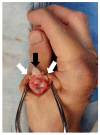

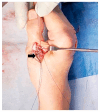

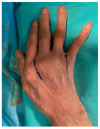
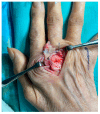

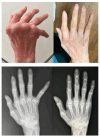
Similar articles
-
Joint replacement for rheumatoid arthritis: When, why, and how! Insights from an orthopedic surgeon.Best Pract Res Clin Rheumatol. 2025 Mar;39(1):102034. doi: 10.1016/j.berh.2025.102034. Epub 2025 Jan 19. Best Pract Res Clin Rheumatol. 2025. PMID: 39828465 Review.
-
Operative correction of swan-neck and boutonniere deformities in the rheumatoid hand.J Am Acad Orthop Surg. 1999 Mar-Apr;7(2):92-100. doi: 10.5435/00124635-199903000-00002. J Am Acad Orthop Surg. 1999. PMID: 10217817
-
The effect of swan neck and boutonniere deformities on the outcome of silicone metacarpophalangeal joint arthroplasty in rheumatoid arthritis.Plast Reconstr Surg. 2013 Sep;132(3):597-603. doi: 10.1097/PRS.0b013e31829ad1c1. Plast Reconstr Surg. 2013. PMID: 23985634 Free PMC article. Clinical Trial.
-
Extensor Indicis Proprius Tenodesis to Correct Finger Ulnar Drift Deformity in Rheumatoid Arthritis.Hand (N Y). 2016 Sep;11(3):336-340. doi: 10.1177/1558944715626929. Epub 2016 Feb 2. Hand (N Y). 2016. PMID: 27698637 Free PMC article.
-
Swan-Neck and Boutonniere Deformity in Rheumatoid Hand.Hand Clin. 2025 Feb;41(1):103-116. doi: 10.1016/j.hcl.2024.08.004. Epub 2024 Oct 18. Hand Clin. 2025. PMID: 39521583 Review.
References
Publication types
LinkOut - more resources
Full Text Sources
Research Materials
Miscellaneous

